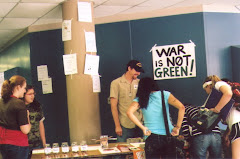
This was great news from the Education Not Arms Coalition in San Diego. At a historic school board meeting of the San Diego Unified School District held earlier this month, students, veterans, parents and other coalition supporters persuaded board members to end the practice of using shooting ranges in the JROTC programs in San Diego high schools. The board decision marked the culmination of a campaign begun by the Education Not Arms Coalition in 2007. Here's their report:
February 10, 2009 - San Diego Unified, located in the middle of one of the largest military complexes in the world, took the uncharacteristic step of banning rifle training conducted under the military's high school JROTC program. Eleven schools with rifle ranges were affected in the nation's eighth largest urban district.
Before the board meeting began, speakers representing local high schools and colleges addressed an outside crowd of 200 students, parents, teachers and community supporters. Some high schools sent so many students that two charter buses, courtesy of the AFSC, were used for transportation. Anticipating a long evening before the school board would discuss the rifle training issue, the Association of Raza Educators provided tamales to help sustain the crowd.
It wasn't until four hours into the board meeting, at 9:00 PM, that the agenda item came up for discussion. The vote was preceded by testimony from about 15 pro- and con- speakers in front of a crowd that was largely in favor of terminating the weapons training program. One school board member said that in all of his many years on the board, this was the most impressive student effort he had ever seen. Even two board members who opposed the resolution expressed their admiration for the students' involvement. When the decision was made, the resolution, which immediately banned all marksmanship training in the district, passed by a vote of 3-2. The crowd then spilled out of the auditorium to hold a loud and joyous celebration.
This achievement was made possible by a collaboration of students and various community groups who first came together in 2007 as the Education Not Arms Coalition. One of their main concerns was the way schools were tracking students into military training (via JROTC) while denying them adequate class alternatives, especially ones needed to qualify for college. Students from African American and Latino families were being disproportionately affected.
To address the problem, the coalition adopted three initial goals--convince the school district to:
-stop placing students into military science (JROTC) classes without their informed consent.
-stop telling parents and students that the class will help them qualify for college, when it won't.
-ban weapons training and JROTC gun ranges in San Diego schools.
All three goals have now been achieved, the first two by a superintendent's directive, the third by school board action. Throughout the over one-year long campaign, high school students have played a central role in educating and mobilizing their peers, with support from a variety of community and college groups.
Audio of the entire Feb. 10 hearing and school board decision is posted on the SD Unified site: http://www.sandi.net/indices/board.htm. Video should be added soon.
Before the board meeting began, speakers representing local high schools and colleges addressed an outside crowd of 200 students, parents, teachers and community supporters. Some high schools sent so many students that two charter buses, courtesy of the AFSC, were used for transportation. Anticipating a long evening before the school board would discuss the rifle training issue, the Association of Raza Educators provided tamales to help sustain the crowd.
It wasn't until four hours into the board meeting, at 9:00 PM, that the agenda item came up for discussion. The vote was preceded by testimony from about 15 pro- and con- speakers in front of a crowd that was largely in favor of terminating the weapons training program. One school board member said that in all of his many years on the board, this was the most impressive student effort he had ever seen. Even two board members who opposed the resolution expressed their admiration for the students' involvement. When the decision was made, the resolution, which immediately banned all marksmanship training in the district, passed by a vote of 3-2. The crowd then spilled out of the auditorium to hold a loud and joyous celebration.
This achievement was made possible by a collaboration of students and various community groups who first came together in 2007 as the Education Not Arms Coalition. One of their main concerns was the way schools were tracking students into military training (via JROTC) while denying them adequate class alternatives, especially ones needed to qualify for college. Students from African American and Latino families were being disproportionately affected.
To address the problem, the coalition adopted three initial goals--convince the school district to:
-stop placing students into military science (JROTC) classes without their informed consent.
-stop telling parents and students that the class will help them qualify for college, when it won't.
-ban weapons training and JROTC gun ranges in San Diego schools.
All three goals have now been achieved, the first two by a superintendent's directive, the third by school board action. Throughout the over one-year long campaign, high school students have played a central role in educating and mobilizing their peers, with support from a variety of community and college groups.
Audio of the entire Feb. 10 hearing and school board decision is posted on the SD Unified site: http://www.sandi.net/indices/board.htm. Video should be added soon.
-- photo from the Education Not Arms site



